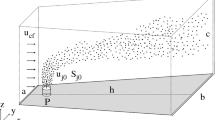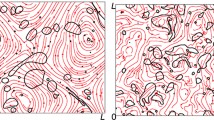Abstract
This study presents discoveries on the spectral trends of energy cascading in turbulent buoyant plumes. A high-resolution large eddy simulation was used to simulate thermal and buoyant gas plumes. Turbulent plumes have positive helicity throughout the spatial development process. The helicity and turbulent kinetic energy spectra reveal consistent trends and demonstrate a deviation from the classical Kolmogorov’s inertial spectra at high wave numbers. Additional insight into turbulence physics has been confirmed in this study: the forward cascading of energy exists only at higher wavenumbers, whereas the flux of energy and helicity flows from smaller to large-scale structures at the lower wavenumbers.











Similar content being viewed by others
Data Availability
The data which support this investigation are available from the corresponding author on reasonable request.
References
Morton BR (1959) Forced plumes. J Fluid Mech 5(1):151–163
Morton BR (1957) Buoyant plumes in a moist atmosphere. J Fluid Mech 2(2):127–144
Woods AW (2010) Turbulent plumes in nature. Annu Rev Fluid Mech 42(1):391–412
Baines PG (2001) Mixing in flows down gentle slopes into stratified environments. J Fluid Mech 443:237–270
Özgökmen TM, Johns WE, Peters H, Matt S (2003) Turbulent mixing in the red sea outflow plume from a high-resolution nonhydrostatic model. J Phys Oceanogr 33(8):1846–1869
Ernst GGJ, Sparks RSJ, Carey SN, Bursik MI (1996) Sedimentation from turbulent jets and plumes. J Geophys Res Solid Earth 101(B3):5575–5589
Carazzo G, Kaminski E, Tait S (2008) On the rise of turbulent plumes: quantitative effects of variable entrainment for submarine hydrothermal vents, terrestrial and extra terrestrial explosive volcanism. J Geophys Res Solid Earth 113:B9
Skyllingstad ED, Denbo DW (2001) Turbulence beneath sea ice and leads: a coupled sea ice/large-eddy simulation study. J Geophys Res Oceans 106(C2):2477–2497
Widell K, Fer I, Haugan PM (2006) Salt release from warming sea ice. Geophys Res Lett. https://doi.org/10.1029/2006GL026262
Briggs G (1967) Chimney plumes in neutral and stable surroundingsshwartz and tulin, atmospheric environment 6, 19–35 (1971). Atmos Environ 6(7):507–510
Bhaganagar K, Bhimireddy SR (2017) Assessment of the plume dispersion due to chemical attack on April 4, 2017, in Syria. Nat Hazards 88(3):1893–1901
Chen CH, Bhaganagar K (2021) New findings in vorticity dynamics of turbulent buoyant plumes. Phys Fluids 33(11):115104
WangFS ZGSM (2022) Plume structures in turbulent natural convection between two vertical walls. Chin Sci Bull 47:955
Kraichnan RH (1967) Inertial ranges in two-dimensional turbulence. Phys Fluids 10(7):1417–1423
Biferale L, Musacchio S, Toschi F (2012) Inverse energy cascade in three-dimensional isotropic turbulence. Phys Rev Lett 108:164501
Alexakis A, Biferale L (2018) Cascades and transitions in turbulent flows. Phys Rep 767–769:1–101
Yakhot V (1999) Two-dimensional turbulence in the inverse cascade range. Phys Rev E 60:5544–5551
Pearson BC, Pearson JL, Fox-Kemper B (2021) Advective structure functions in anisotropic two-dimensional turbulence. J Fluid Mech 916:A49
Yakhot V, Pelz R (1987) Large-scale structure generation by anisotropic small-scale flows. Phys Fluids 30(5):1272–1277
Xia H, Byrne D, Falkovich G, Shats M (2011) Upscale energy transfer in thick turbulent fluid layers. Nat Phys 7:321–324
Lilly DK (1983) Stratified turbulence and the mesoscale variability of the atmosphere. J Atmos Sci 40(3):749–761
Bartello P (1995) Geostrophic adjustment and inverse cascades in rotating stratified turbulence. J Atmos Sci 52(24):4410–4428
Smith LM, Waleffe F (1999) Transfer of energy to two-dimensional large scales in forced, rotating three-dimensional turbulence. Phys Fluids 11(6):1608–1622
Christensson M, Hindmarsh M, Brandenburg A (2001) Inverse cascade in decaying three-dimensional magnetohydrodynamic turbulence. Phys Rev E 64:056405
Byrne D, Zhang JA (2013) Height-dependent transition from 3-d to 2-d turbulence in the hurricane boundary layer. Geophys Res Lett 40(7):1439–1442
Tang J et al (2015) Horizontal transition of turbulent cascade in the near-surface layer of tropical cyclones. J Atmos Sci 72(12):4915–4925
Callies J, Ferrari R, Bühler O (2014) Transition from geostrophic turbulence to inertia-gravity waves in the atmospheric energy spectrum. Proc Natl Acad Sci U S A 111(48):17033–17038
Frishman A, Laurie J, Falkovich G (2017) Jets or vortices–what flows are generated by an inverse turbulent cascade? Phys Rev Fluids 2:032602
Plunian F, Teimurazov A, Stepanov R, Verma MK (2020) Inverse cascade of energy in helical turbulence. J Fluid Mech 895:A13
Chen CH, Bhaganagar K (2023) Energetics of buoyancy generated turbulent flows with active scalar: pure buoyant plume. J Fluid Mech 954:A23
Bhaganagar K, Bhimireddy SR (2020) Numerical investigation of starting turbulent buoyant plumes released in neutral atmosphere. J Fluid Mech 900:A32
Bhimireddy SR, Bhaganagar K (2021) Implementing a new formulation in WRF-LES for buoyant plume simulations: bplume-wrf-les model. Mon Weather Rev 149:2299–2319
Bhamidipati N, Woods AW (2017) On the dynamics of starting plumes. J Fluid Mech 833:R2. https://doi.org/10.1017/jfm.2017.762
Ai J, Law AW-K, Yu SCM (2006) On boussinesq and non-boussinesq starting forced plumes. J Fluid Mech 558:357–386
Maqui AF (2016) Turbulence generation using localized sources of energy: direct numerical simulations and the effects of thermal non-equilibrium. Ph.D. thesis, Texas A &M University
Maqui AF, Donzis DA (2016) Turbulence generation through intense kinetic energy sources. Phys Fluids 28(6):065106
Okui H, Sato K, Watanabe S (2022) Contribution of gravity waves to universal vertical wavenumber (\(\sim \text{m}^{-3}\)) spectra revealed by a gravity-wave- permitting general circulation model. J Geophys Res Atmos 127:e2021JD036222
Sato K, Watanade S, Kawatani Y, Tomikawa Y, Miyazaki K, Takahashi M (2009) On the origins of mesospheric gravity waves. Geophys Res Lett. https://doi.org/10.1029/2009GL039908
Kolmogorov AN, Levin V, Hunt JCR, Phillips OM, Williams D (1991) Dissipation of energy in the locally isotropic turbulence. Proc R Soc Lond A 434(1890):15–17
Acknowledgements
The authors would like to acknowledge Texas Advanced Computing Center (TACC) for computational resources and NASA for financial support. The authors acknowledge the graduate students in the Laboratory of Turbulence and Sensing at the University of Texas, San Antonio who have helped with the generation of the LES data and for developing python tool for post-processing the LES data.
Author information
Authors and Affiliations
Corresponding author
Ethics declarations
Conflict of interest
The authors declare no conflict of interest.
Additional information
Publisher's Note
Springer Nature remains neutral with regard to jurisdictional claims in published maps and institutional affiliations.
Rights and permissions
Springer Nature or its licensor (e.g. a society or other partner) holds exclusive rights to this article under a publishing agreement with the author(s) or other rightsholder(s); author self-archiving of the accepted manuscript version of this article is solely governed by the terms of such publishing agreement and applicable law.
About this article
Cite this article
Chen, C.H., Bhaganagar, K. Turbulent cascading in Buoyant plumes. Environ Fluid Mech (2024). https://doi.org/10.1007/s10652-023-09963-9
Received:
Accepted:
Published:
DOI: https://doi.org/10.1007/s10652-023-09963-9




